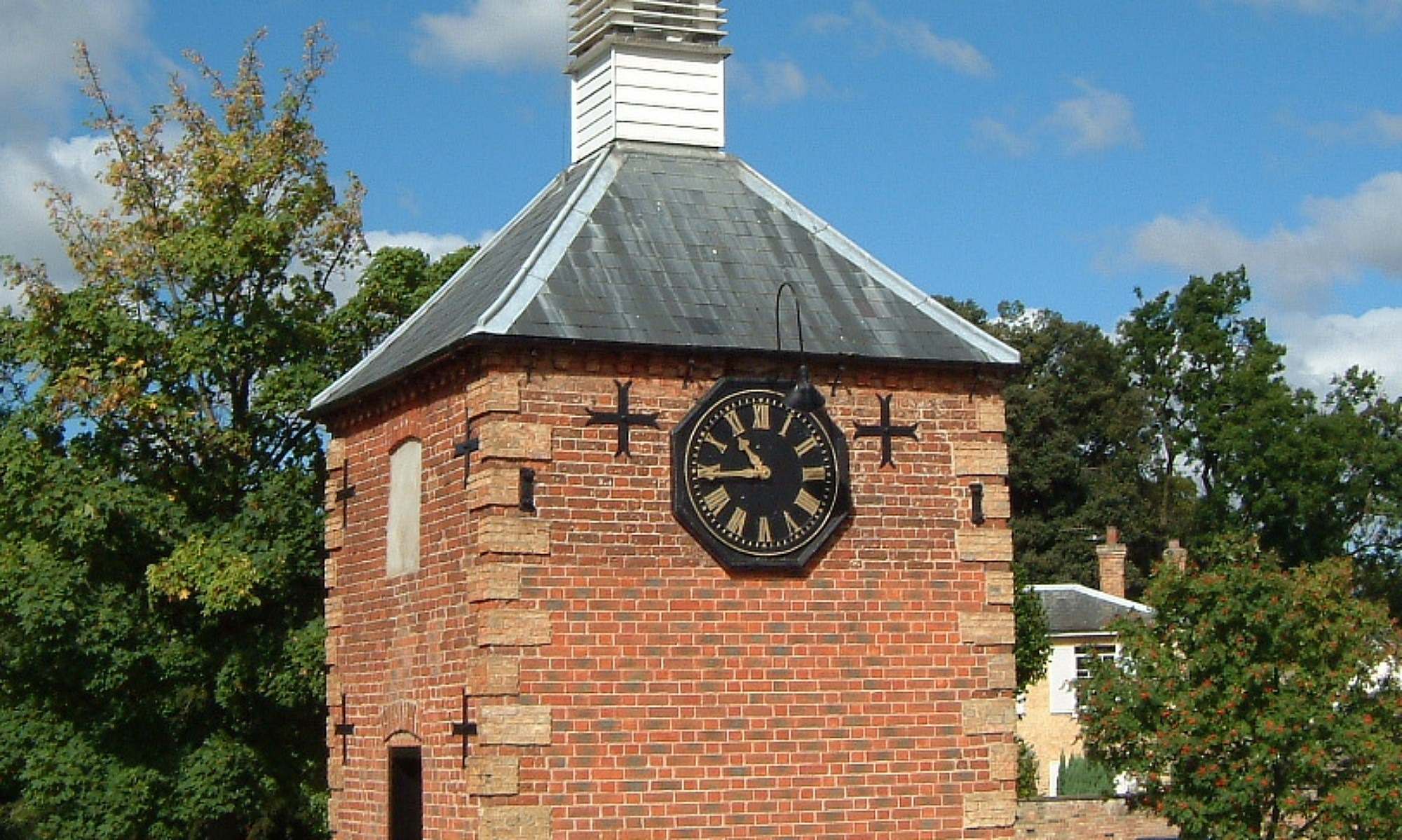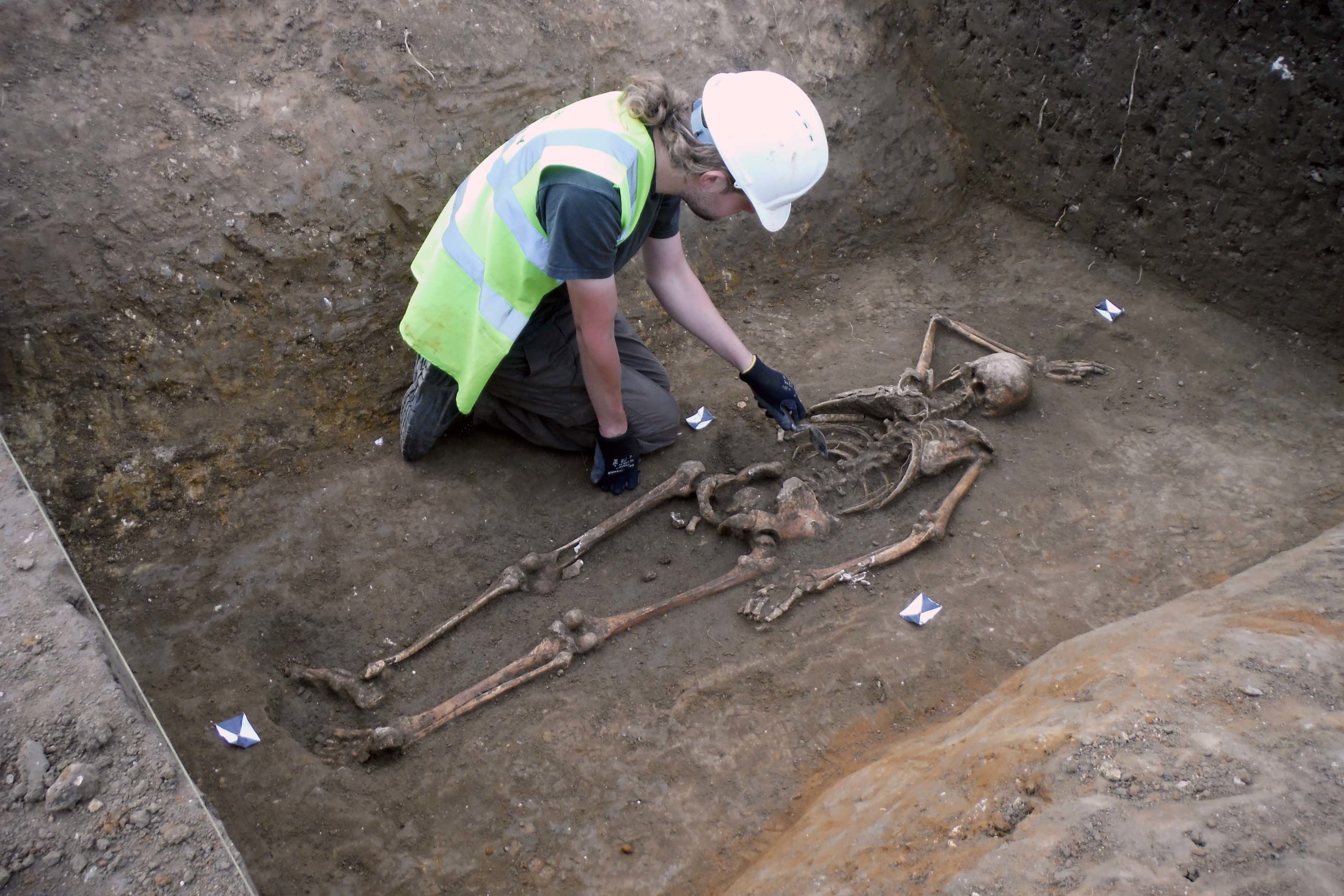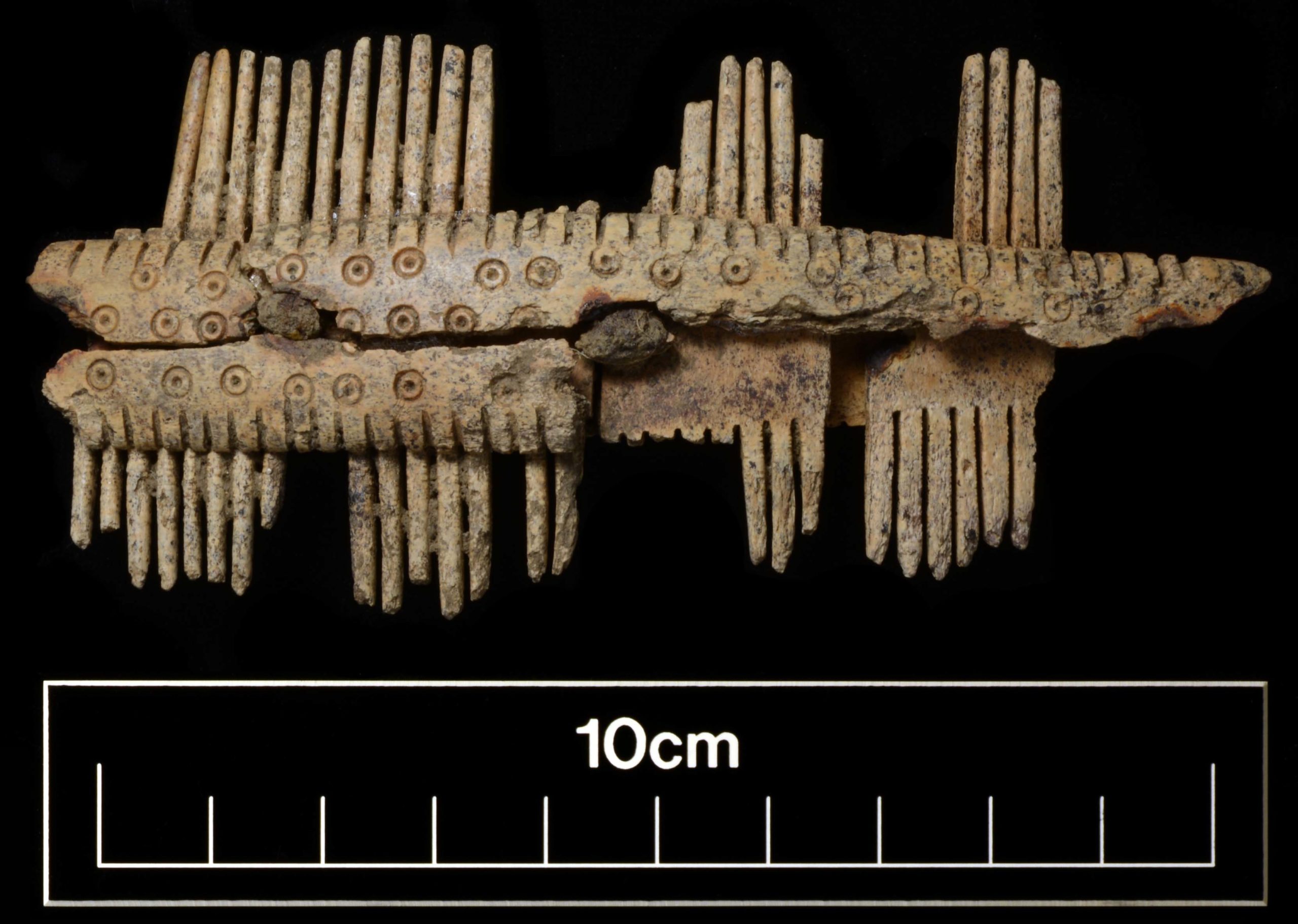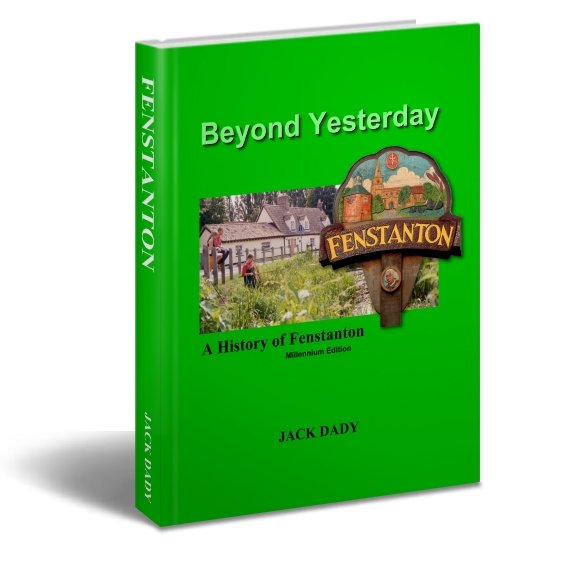The first example of a Roman crucifixion in the UK has been found in a Cambridgeshire village.
Albion Archaeology discovered a large, previously unknown Roman roadside settlement in 2017 while carrying out an excavation in Fenstanton, Cambridgeshire on behalf of Tilia Homes (previously Kier Living). Finding Roman burials on such a site is common, and this was no exception – yet one of the people buried at Fenstanton had been crucified.
Archaeologists investigating a previously unknown Roman roadside settlement, which includes five small cemeteries, discovered in one grave the remains of a man with a nail through his heel.
Only one previous example like this of crucifixion has been found worldwide, in Israel, although two possible instances have also been claimed in Italy and Egypt. However, the Fenstanton example is the best preserved.
The exciting discovery follows on from previous historically significant digs across Cambridgeshire in recent years which have uncovered preserved Bronze Age buildings and artefacts at Must Farm in Whittlesey, pristine prehistoric occupation sites and burial monuments in Needingworth Quarry, and new Iron Age, Roman and Anglo-Saxon settlements that emerged during the course of the recent A14 road improvement scheme around Cambridge.
The cemeteries and man who was crucified were discovered during excavations of two sites in advance of new housing developments by Tilia Homes (previously known as Kier Living) south of Cambridge Road, and by Morris Homes at the former Dairy Crest brownfield site. The excavations were led by David Ingham of Albion Archaeology.
Osteologist (human bone specialist) Corinne Duhig from Wolfson College, Cambridge, said: “The lucky combination of good preservation and the nail being left in the bone has allowed me to examine this almost unique example when so many thousands have been lost.
“This shows that the inhabitants of even this small settlement at the edge of empire could not avoid Rome’s most barbaric punishment.”
Inside the cemeteries, 40 adults and five children were buried, with specialist study showing that some family groups were present. The Roman settlements, now fully excavated, also included a number of archaeologically significant artefacts.
The results of the excavation will be formally published when analysis of the site’s finds and evidence has been completed.
Speaking for Cambridgeshire County Council’s Historic Environment Team, archaeologist Kasia Gdaniec said: “These cemeteries and the settlement that developed along the Roman road at Fenstanton are breaking new ground in archaeological research.
“Burial practices are many and varied in the Roman period and evidence of ante-or post-mortem mutilation is occasionally seen, but never crucifixion.
“We look forward to finding out more when the results are published. Hopefully, there will be a museum exhibit to showcase the remains soon, and we are working to arrange this. We are grateful to the developers for funding these important investigations as part of their planning obligation.”
Fenstanton lies on the Via Devana, the road which linked the Roman towns at Cambridge and Godmanchester. While numerous Iron Age sites are known in the area, this roadside settlement appears to have been an essentially new Roman venture on the line of the road, covering at least 6 hectares and possibly situated at a crossroads. The presence of an early Anglo-Saxon grubenhaus or sunken-floored building points to some level of continued post-Roman habitation after the 4th century.
Support from Tilia Homes meant that the central, best-preserved part of the settlement was left undisturbed by the new housing development. The excavation focused on the enclosures around the edge, away from the domestic areas – though the footings of a large wooden building and traces of stone street or yard surfaces were found in the areas closest to the centre.
One of these enclosures contained large numbers of animal bones that suggest the presence of a large-scale industrial operation. Cattle bones were being split in such a way that large amounts of marrow and grease would have been released – for the manufacture of items such as soap or tallow for candles. The bones are likely to have come from a combination of cattle that were kept at Fenstanton, as well as carcasses that were imported from a nearby Roman town specifically for specialist butchers to process them here.
The excavation also revealed a number of Roman graves, mostly clustered into small cemeteries – the size of household cemetery plots, though DNA evidence identified surprisingly few family groupings. Analysis of the skeletons has revealed that the mostly adult population suffered from a large number of injuries and illnesses. None of the graves appeared remarkable during excavation – but while one of the skeletons was being washed back at the lab, it was found to have a nail through its heel.
The skeleton was that of a man aged roughly 25–35, with signs of poor dental health and arthritis that were common among many of the people buried here. There were also signs of thinning on his lower legs, which may have been caused by infection or inflammation or perhaps by local irritation from being bound or shackled.
Twelve nails that were found around the skeleton suggest that he had been placed on a board or a bier (probably not in a coffin), but the 13th had passed horizontally through his right heel bone (calcaneum). It seems implausible that the nail could have been accidentally driven through the bone during construction of the timber support on which the body was placed – indeed, there are even signs of a shallow second hole that suggests an unsuccessful first attempt to pierce the bone.
While this cannot be taken as incontrovertible proof that the man was crucified, it seems the only plausible explanation – making it at most the fourth example ever recorded worldwide through archaeological evidence. Crucifixion was relatively commonplace in Roman times, but the victims were often tied to the cross rather than nailed, and if nails were used then it was routine to remove them afterwards. Only one other example has been found with a nail surviving in situ through the bone, discovered at Giv‘at ha-Mivtar in north Jerusalem during building work in 1968; skeletons with a similar hole have also been found at Gavello in Italy and at Mendes in Egypt, but without a nail in place and with doubt over how the holes had been formed.
The remarkable fact about this skeleton is not that the man was crucified, but that his body was reclaimed after death and given a formal burial alongside others, leaving us with this extremely rare evidence of what had happened to him.
An iron nail penetrated his right heel bone (calcaneum) horizontally, consistent with crucifixion. His feet would have been nailed to the sides of an upright timber.
In life he had suffered from poor health and injury, and his ankles may have been shackled. The victim may have been a slave.
This is the best physical evidence for a crucifixion in the Roman world – the only instance from northern Europe and the fourth reported worldwide. No nails are associated with two of the others, and plant roots may have caused the holes. Previously unique is a heel bone excavated in Israel in 1968, with a nail in the same position as the new find. It was less well preserved and was reburied, and there has been controversy about the find.
The grave was in a small cemetery, one of five around a newly discovered Roman settlement at Fenstanton, between Roman Cambridge and Godmanchester.
The site of crucifixion is unknown, but is likely to have been elsewhere, probably beside a road.
The man’s bones have been radiocarbon dated to between AD130 and 360. Constantine, acclaimed emperor in York (306–337), is thought to have banned crucifixion, so the man likely died between 130 and 337.
The nail was not seen until conservation occurred off site. Prolonged analysis by Corinne Duhig, archaeologist at the University of Cambridge who examined the human remains from Fenstanton, established crucifixion as the only likely explanation. Signs of punitive injuries and immobilisation before and around the time of death, says Duhig, suggest the victim may have been a slave.
Romans reserved crucifixion for condemned slaves, rebels and lower classes. Cicero was among writers who criticised the cruel practice, designed to prolong an agonising death.
Crucifixion nails are thought to be so rare because:
- Crucified people would not often have received proper burial.
- Crucifixion was often done with rope.
- Nails would have been recycled for their metal value, and may also have been collected for perceived magical properties.
The exact location of the crucifixion is not being disclosed to respect the privacy of the current homeowner.
A detailed article on the excavation can be found in the British Archaeology magazine at
Crucifixion in the Fens: Life and Death in Roman Fenstanton
Background
Fenstanton is a quaint, historic roadside village whose High Street follows the route of the Via Devana, which linked the Roman towns of Cambridge and Godmanchester.
In 2017 and 2018, Albion Archaeology excavated two sites in advance of new housing developments by Tilia Homes (previously known as Kier Living), south of Cambridge Road, and by Morris Homes at the former Dairy Crest brownfield site.
Some of the more noteworthy findings included enamelled brooches, large numbers of coins, decorated fine ware pottery and large amounts of animal bones displaying specialist butchery methods. These, along with a large building and formal yard or road surfaces, indicated the presence of an organised Roman settlement with obvious signs of trade and wealth.
This settlement might have been maintained as a formal stopping place along the road to service travellers around which the village grew, and there is some evidence to suggest that it developed at a crossroads.
Forty adults and five children were buried in the five small cemeteries that dated to the third to fourth centuries AD, while three isolated burials and a cremation also occurred.
Ancient DNA study of the skeletons identified only two family groups, despite this being a small rural settlement where you would expect many people to be related.
A man and woman buried next to each other in one cemetery had a first-degree relationship – either as mother-son or as siblings – while two men in adjacent graves in another cemetery were second-degree relatives, so could be either half-siblings, uncle-nephew or grandfather-grandson.
Overall, the population had signs of poor body health, terrible dental disease and some showed signs of malaria. Evidence of physical trauma including fractures was also seen in most of the bodies.
One particular skeleton of a man had been laid out in his grave like all the rest. However, a large iron nail penetrated the right heel bone (calcaneum) horizontally, exiting below the protrusion called the sustentaculum tali.
His skeleton revealed other injuries and abnormalities that indicated he had suffered before he died, while his legs had signs of infection or inflammation caused by either a systemic disorder or by local irritation such as binding or shackles.
Although crucifixion was common in the Roman world, osteological evidence for the practice is unlikely to be found because nails were not always used and bodies might not appear in formal burial settings.
Unlike the most famous Christian example of the crucifixion of Jesus, who was unusually nailed by his hands and feet to a cross, victims or prisoners were more commonly tied by the arms to the crossbar of a T-shaped frame called a ‘patibulum’ and their legs braced and tied, sometimes nailed, to either side of the upright post.
This was part of a cruel, ancient method of slow punishment of both miscreants of shameful crimes and a vast number of slaves who were crucified because of minor misdemeanours. This form of punishment was eventually abolished by Constantine I in the 4th Century AD.
Corinne has researched the evidence of crucifixion from this period around the world, finding only three other examples: one from La Larda in Gavello, Italy, one from Mendes in Egypt and one from a burial found at Giv‘at ha-Mivtar in north Jerusalem, found during building work in 1968.
Only the last one is a convincing example of crucifixion, she said, because the right heel bone retained a nail which was in exactly the same position as that from the Fenstanton burial. It was usual practice to remove any nails after crucifixion for re-use, discard or use as amulets, but in this case the nail had bent and become fixed in the bone.








